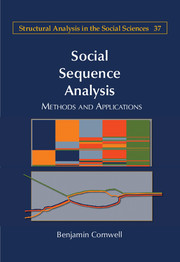Book contents
- Frontmatter
- Contents
- List of Figures
- List of Tables
- Preface
- Acknowledgments
- PART I INTRODUCTION
- PART II THEORETICAL BACKGROUND
- PART III SOCIAL SEQUENCE ANALYSIS CONCEPTS AND TECHNIQUES
- PART IV NEW DIRECTIONS IN SOCIAL SEQUENCE ANALYSIS
- 6 Network Methods for Sequence Analysis
- 7 Social Microsequence Analysis
- PART V CONCLUSIONS
- Appendix A Recent Whole-Sequence Pattern Analyses
- Appendix B Linkage Criteria for Agglomerative Hierarchical Clustering
- References
- Index
- Recent Books in the Series (continued from page iii)
6 - Network Methods for Sequence Analysis
from PART IV - NEW DIRECTIONS IN SOCIAL SEQUENCE ANALYSIS
Published online by Cambridge University Press: 05 July 2015
- Frontmatter
- Contents
- List of Figures
- List of Tables
- Preface
- Acknowledgments
- PART I INTRODUCTION
- PART II THEORETICAL BACKGROUND
- PART III SOCIAL SEQUENCE ANALYSIS CONCEPTS AND TECHNIQUES
- PART IV NEW DIRECTIONS IN SOCIAL SEQUENCE ANALYSIS
- 6 Network Methods for Sequence Analysis
- 7 Social Microsequence Analysis
- PART V CONCLUSIONS
- Appendix A Recent Whole-Sequence Pattern Analyses
- Appendix B Linkage Criteria for Agglomerative Hierarchical Clustering
- References
- Index
- Recent Books in the Series (continued from page iii)
Summary
Chapters 3–5 covered conventional social sequence analysis methods, some of which focus on comparing sequences and identifying common holistic sequence profiles based on patterns of dissimilarities among sequences. This chapter introduces a new approach to analyzing sequences. Whereas social sequence analysts typically arrive at sequence profiles by viewing actors in terms of how different their sequences are from each other, the approach described in this chapter views sequence elements as bases of relationships that link actors together. This perspective lends itself to the use of social network analysis (SNA) techniques (Wasserman and Faust 1994). With this set of tools, it is possible to (1) assess the structural importance of specific elements, positions, or actors in observed sequence patterns, (2) identify sets of elements, positions, and actors that form cohesive subsequences, and (3) simultaneously portray diagrammatically both the distributions of elements in a population across different time points and the transitions that occur at specific time points.
This chapter outlines theoretical foundations for treating sequences as sources of connectedness between subjects and presents some techniques that can be used to analyze those connections in ways that can yield new insights into the structure of sequences. I begin by sketching the theoretical basis, in keeping with the discussion in Chapter 2, which involves recognizing that sequences link subjects together in experience. After introducing some foundational network-analytic concepts, terms, and notation, I discuss network-analytic approaches to analyzing and visualizing social sequence data. My main focus will be on how to measure the roles played by various subjects and elements in connecting subjects and their sequences together, how to identify subsets of elements, and how to depict sequences as networks.
Theoretical Rationale
The methods described in this book are responsive to the relational critique of social science research (Emirbayer 1997). Despite the fact that many social science theories implicitly concern dynamic social processes and social relationships, empirical analysis is often organized around variables that tend to reflect static states, or “substances,” that are frozen in time or unrelated to each other. Conventional social sequence analysis embodies the relational approach in several respects.
Information
- Type
- Chapter
- Information
- Social Sequence AnalysisMethods and Applications, pp. 155 - 209Publisher: Cambridge University PressPrint publication year: 2015
Accessibility standard: Unknown
Why this information is here
This section outlines the accessibility features of this content - including support for screen readers, full keyboard navigation and high-contrast display options. This may not be relevant for you.Accessibility Information
- 1
- Cited by
